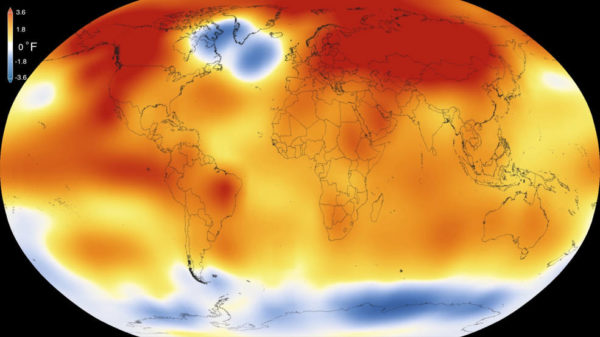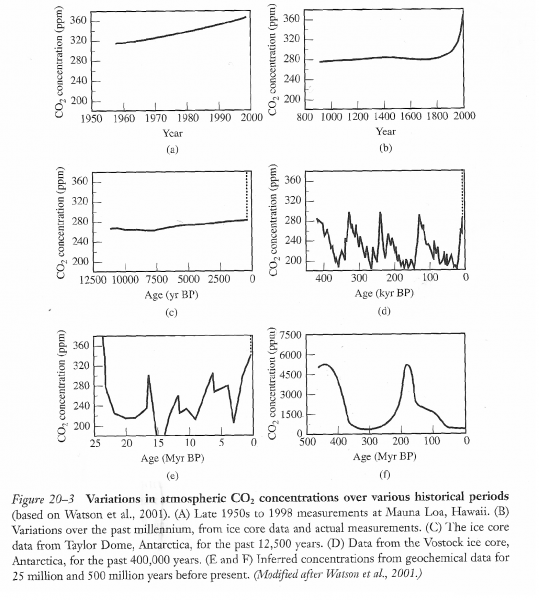This is an in-depth post about contested subsidies for nuclear power plants in Central New York. A few prominent anti-nuclear groups are strongly working against these subsidies. At the moment, their strategy is to make an economic and taxation argument – that these subsidies cost too much, that it raises our electric bills, and is a bailout of “big business”.
My interest in this topic surrounds climate change, and about discourse based on facts with a minimum of spin and propaganda. We need more transparency behind what we claim are facts, so people have enough information to judge for themselves. In this spirit, I offer this work, deconstructing the argument that these subsidies are “bad” and providing links and information that anyone who wants to can follow.
____________________________________________________________________
There has been plenty of information and data in the reporting on the bailout or subsidies for Upstate nuclear plants, but the reporting is lacking context related to the role of hydrofracked natural gas (fracking), comparisons to the subsidies renewable energy receive, and longer term analysis of electricity prices. This missing context is crucial to understanding impacts on climate change and to better understand the nature of anti-nuclear spin and propaganda.
Electricity Prices and Natural Gas
Let’s start with electricity pricing and prices. The graph below helps us understand the history of electricity prices in New York State over the past 15 years (dark blue line) and how linked it is to the cost of natural gas (yellow line). They are linked for a number of reasons but suffice it to say that the price of natural gas heavily influences the price of wholesale electricity.
As seen in the graph below, from 2000 to 2003 and about 2009 to 2013, the cost of electricity fluctuated around $55 per MegaWatt-hour (MWh), a unit of energy, seen in the light blue horizontal line. This is an important number to remember. The cost was significantly higher from about 2004 to 2008 ($65 to $95 per MWh). Further, the graph doesn’t show month to month changes or swings which can be even larger. For instance, residents of Central New York may remember that electric prices shot up in January and February of 2014 to about $160 per MWh due to high demand for natural gas in the winter. This was just before fracking brought prices down to a historic, stable 15 year low for the rest of 2014, 2015 and onward. (NYISO Power Trends 2016 – also the source for the graph below). This price decrease occurred because of the start of fracking in Pennsylvania, with lots of cheap natural gas coming to New York State through pipelines. The price of electricity has since stayed in the $40 to $45 per MWh range due continued fracking.
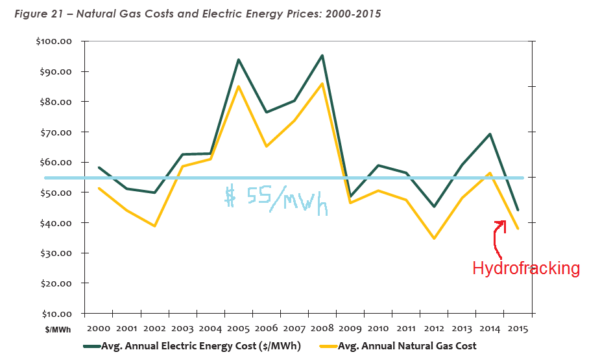 The effects of low electric prices due to fracking on nuclear power
The effects of low electric prices due to fracking on nuclear power
The Fitzpatrick nuclear power plant in Scriba, NY (near Oswego) sells its electricity at the wholesale rate and needs a price of about $50 per MWh to break even and about $55 per MWh to make what’s considered a good profit. For most of the last 15 years, therefore, Fitzpatrick was making a good profit and was doing extremely well in 2004 to 2008. It’s only been struggling in the last couple of years because of the low $45 per MWh price caused by fracking. Therefore, arguments about the high cost and expense of nuclear power related to Fitzpatrick simply don’t make sense. Fitzpatrick is in trouble because of fracking, something environmentalists detest.
The new development of fracking, put Fitzpatrick in financial trouble and it was actually scheduled to close in January 2017, but for action by the State and Cuomo. What a shame if the 600 employees of the plant would have lost their jobs, especially in a small town highly dependent on the economic benefits of the power plant. Further, we know fracking is “boom and bust” – wells produce for only a few to several years – so natural gas prices are likely to go up within a few to several years in which case Fitzpatrick will be profitable on its own again, without any help or subsidies.
This explains the speed and nature of the subsidies put together to help Fitzpatrick. To help justify the subsidies, it was also noted that nuclear energy produces very little CO2 or other greenhouse gas emissions: it doesn’t cause climate change and global warming like fossil fuels do. Wind and solar energy receive subsidies because they don’t contribute to climate change, so why wouldn’t it be fair for nuclear to receive subsidies based on CO2 as well? That’s how the thinking went.
As a result, the Public Service Commission suggested an initial subsidy of about $17.50 per MWh. Based on the increasing costs of climate change over time, the PSC had the subsidy increasing gradually to as high as $29 per MWh within 11 to 12 years. These subsidies are based on an assumed wholesale price of $39 per MWh, so the initial subsidy would mean the power plant gets a little over $55 per MWh, which is profitable.
Now the catch is that the subsidies also have a provision so if the cost of electricity goes up on its own, the subsidies will decrease by the same amount. This makes sense and is very fair – the power plant will only get subsidies if it really needs them. Due to the expected slowdown of fracking and for other reasons, the cost of electricity is expected to be back up to about $65 per MWh within 6 years. When this happens, Fitzpatrick won’t be receiving any subsidies because it will be very profitable on its own (i.e. wholesale price of electricity is greater than the profitable value of $55 per MWh).
So why are people raising such a big stink about these subsidies, which are just a temporary measure?
Well, a big part of it is spin: these subsidies will cost taxpayers BILLIONS.
The cost of the subsidies, and comparisons to renewable energy subsidies
An average household will pay about $2 a month more in its electricity bill because of these subsidies. That’s $24 a year, and when multiplied by the millions of people in New York State, that does in fact add up to BILLIONS of dollars. But it’s still just 2 bucks a month.
Further, I haven’t seen any articles or reporting on this topic point out that hey, your electricity bills actually fell by about $2 a month because of fracking. This subsidy therefore isn’t really increasing people’s overall electricity bills, it’s just restoring them by $2 to the level before fracking. Because of this, arguments about the excessive cost of these subsidies really fall apart in my view. Something else must be going on beneath them.
But before I get to that, let’s take a quick look at the subsidies that renewable energy require. Wind energy has been growing in New York State, and this is a great thing. Yet, wind energy is still reliant on subsidies, as seen in the following graph from the Union of Concerned Scientists. The story is this: Congress has to re-approve subsidies for wind turbines every few years. When these subsidies are in place, we start ramping up the number of wind turbines we build each year. But then the subsidies are up for re-approval, and businesses just don’t know if they’ll be approved, so they don’t build as many turbines. If the subsidies are approved, then it starts building up again from the low level and if they aren’t approved, then they fall even further. You can see this in the graph below.
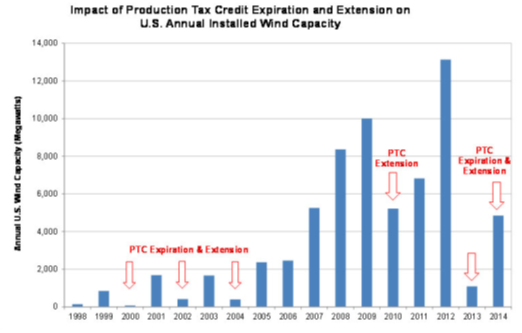 Source: Union of Concerned Scientists.
Source: Union of Concerned Scientists.
How much do subsidies for renewable energy cost, and how do they compare to the nuclear subsidies? Well, subsidies for wind and solar power in New York State have ranged from about $22 per MWh to $35 per MWh, for 20-year fixed terms. The Fitzpatrick subsidies range from $17.50 to $29 per MWh, but go away if electricity prices go up. Wind and solar subsidies stay in place.
So we actually pay a little bit more in subsidies for wind than for Fitzpatrick and within 6 years will likely pay no subsidies whatsoever for Fitzpatrick. Not only that, but wind and solar receive federal subsidies as well, on top of the state subsidies.
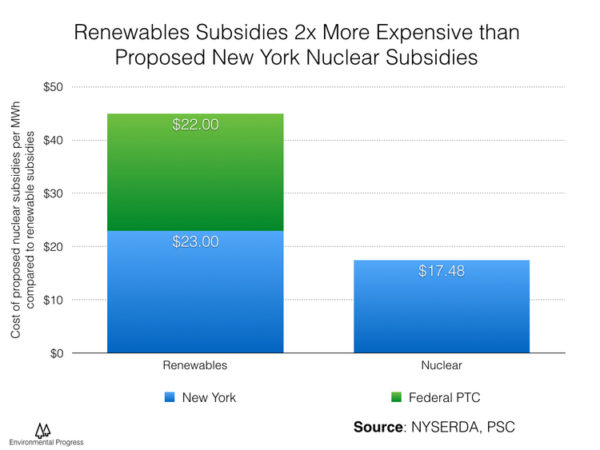 Hang with me, I’ve got one more line of thinking and reasoning, then I’ll wrap up.
Hang with me, I’ve got one more line of thinking and reasoning, then I’ll wrap up.
How much wind would power it take to replace Fitzpatrick?
Some groups such as the Alliance for a Green Economy (AGREE) argue that Fitzpatrick should be shut down and its energy replaced by renewables. As an example, how much wind power in particular would it take to replace Fitzpatrick, how feasible is this, and how does this all look in the context of climate change?
The Fitzpatrick nuclear power plant produces 850 MW of power. You might think that 850 MW of wind power would replace it, but it wouldn’t. The catch is that the nuclear power plant produces this power basically around the clock, while wind turbines produce power only when the wind is blowing fast enough. The concept that describes this is called the “capacity factor”. Nuclear in NY State has a capacity factor of 94%, while wind has a capacity factor of 26%. This means that nuclear power plants ran 94% of the entire year of 2015, while wind turbines spun only 26% of the entire year of 2015. Therefore it takes the ratio of 94/26 = 3.6 times as many MegaWatts of wind power to get the same amount of electricity as 1 MW of nuclear power. Therefore it will take 850 x 3.6 = 3060 MW of wind power to replace the electricity produced by Fitzpatrick.
Is 3060 MW of wind power a lot? Let’s look at how much wind power all of New York State has.
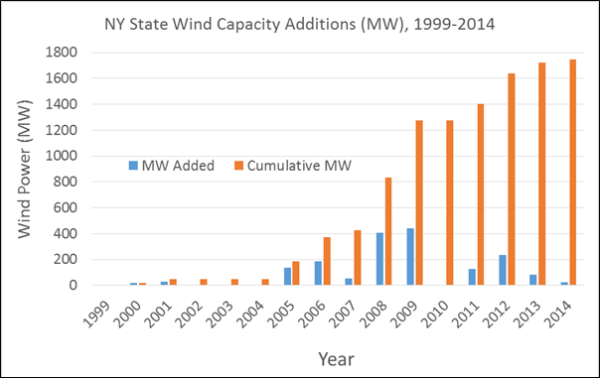 NY State Wind Power Capacity Additions (MW). The blue color shows the number of MW’s that were installed in each year, while the orange color keeps track of the cumulative or total number of wind MWs installed. Source: US Department of Energy statistics
NY State Wind Power Capacity Additions (MW). The blue color shows the number of MW’s that were installed in each year, while the orange color keeps track of the cumulative or total number of wind MWs installed. Source: US Department of Energy statistics
According to statistics from the US Department of Energy, from 1999 to 2014 a total of just under 1800 MW’s of wind power were installed in New York State. Shutting down Fitzpatrick would lead to the loss of the equivalent of 3060 MW’s of wind energy, setting us back roughly 20 years of building wind turbines. Basically, Fitzpatrick alone produces the amount of energy that all our wind turbines in the whole state plus 70% more produce! So it is simply not true that the energy from the power plant could be quickly replaced by wind turbines.
Why not subsidize the nuclear power plant for the maybe 6 years it needs it, pay a couple of bucks a month, and also build lots of new wind and solar panels? Why do some groups make it out to be either/or? Climate change is a pressing concern. Why do we need to go backwards on climate change by shutting down Fitzpatrick?
Wrapping up
I hope this piece has made it clear that our local nuclear power plant – and all the jobs and people it supports – is only in financial trouble because of hydrofracking. Why would we let hydrofracking kill this nuclear power plant? We all seem to agree we should pay a little more for renewable energy. So why not pay just a little more to keep this plant open – 2 bucks a month for just 6 years, especially when our bills have gone down by the same amount anyway because of hydrofracking? It blows my mind that the core argument against the nuclear subsidies implies an acceptance of the status quo with hydrofracking and the savings we get from it.
I can’t escape any other conclusion than that the arguments against the subsidy are really a front for being against nuclear power in general. It only makes sense to be against these subsidies if you really want the plant to close, period, no matter what. And why would we want a plant to close that provides so much of our electricity, jobs to a small town that desperately needs them, and that provides electricity with almost no greenhouse gas emissions? We would only want that if we were absolutely convinced that nuclear energy – or at least this particular nuclear reactor – is unsafe, an imminent danger, or that it’s already caused loads of cancers in people. We should instead be focused on ways to phase out fossil fuels.
The truth is that nuclear power in the United States is extremely safe and has an amazing safety record. There have been only two major nuclear accidents around the world, yet there have been countless deaths caused by fossil fuels that far outstrip all the deaths caused by nuclear. Further, fossil fuels have been causing climate change, which has already caused suffering and will only continue to cause more suffering in the future. New nuclear reactors with advanced and passive safety systems promise even safer power.
I hope this has made a convincing case that all this talk about subsidies and taxpayer burdens and unfairness and “The Cuomo Tax” (check out the link) is all a front for people who want to shut down nuclear reactors at any cost, at any price…even at the price of the communities around them and the employees at the reactors. So if you equate nuclear energy with the doomsday, then by all means, be against these subsidies. But say what you really mean, and don’t hide behind all this talk about #StopTheCuomoTax.

